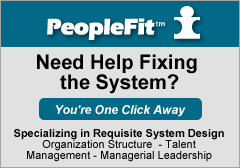Hidden High Potentials and Underachievers – There is a Blog for You!
By Michelle Malay Carter on March 26, 2009
 My friend Forrest of Requisite Writing, a blog aimed at hidden high potentials aka underachievers, thinks the advice I offered young, high potential leaders about using wait time for character building in my last post was a bit naive, maybe uninformed – my words, not his.? He did, however, give me credit for being well intentioned.?
My friend Forrest of Requisite Writing, a blog aimed at hidden high potentials aka underachievers, thinks the advice I offered young, high potential leaders about using wait time for character building in my last post was a bit naive, maybe uninformed – my words, not his.? He did, however, give me credit for being well intentioned.?
Check Out Requisite Writing
Forrest is passionate about this subject, and I thought his comment deserved highlighting.? Here’s what he had to say.? I encourage you to visit his blog for more on the subject.
“You?re well-intended [Michelle], but I don?t think you understand the psychic damage of never being understood. These hidden high potentials outpace us all; they have no one to talk to. It?s all well and good to tell someone who is effectively ostracized to love everyone back, but being always left out will take it?s toll. Can you imagine never having been really seen by anyone?
I have met few hidden high potentials (Mode 7 and above*) who didn?t have character in truckloads. Otherwise they?d have suicided. If they won the lottery, they wouldn?t become failures again because they aren?t flash in the pans: they?ve been working hard. And these instances of instant success killing you are when the recipient does not have the capacity to manage the new situation. Hidden high potentials don?t have that problem.
It?s true that there?s almost nothing that they can do. And that success, if it has not come early, will likely never come in our present society. They have to find love for people who hate them, put up with insults and condescension, suffer never having a real friend who sees them or mentors to help, and then if they do find success, they must ?embrace it humbly, and then use your position, power, or prestige for the benefit of humanity.?
Why do we expect Perfection out of them but are willing to have everyone else be imperfect humans?
Why, if these hidden high potentials who have such developed character are so much better, do we not look for them and raise them up to lead us, but instead look for the flashy high potentials who have always known success?
Stan?s right that it makes greater leaders. But it destroys them in the process.
I pity anyone not ?tapped? who?s Mode 7+. Most of them do indeed wait in a ?just as soon as? state, as did the ancients, waiting for a Messiah or for one to return.”
I’m OK.??You’re OK.? Let’s fix the system.? Are you an untapped high potential underachiever?
*Mode refers to the level of cognitive capability one will reach at the end of their careers.? These map to work levels.??Thus, a Mode 7 person would be cognitively capable?of work at work level 7 at the end of his/her career.
Filed Under Employee Engagement, High Potential, Requisite Organization, Talent Management | 3 Comments
Young, High Potential Leaders – Use Wait Time to Build Character
By Michelle Malay Carter on March 25, 2009
 In terms of requisite cognitive capability, high potentials graduate from college with the ability to problem solve at work level 3 or 4.? Which loosely translates into a director or vice president type role within an organization.??I say?loosely because?we know without a collective understanding that a universal measurement system exists for work, titles are useless for benchmarking.
In terms of requisite cognitive capability, high potentials graduate from college with the ability to problem solve at work level 3 or 4.? Which loosely translates into a director or vice president type role within an organization.??I say?loosely because?we know without a collective understanding that a universal measurement system exists for work, titles are useless for benchmarking.
An Ironic Burden or an Intentional Design?
Unfortunately, generally these high potential leaders?lack the knowledge, skills, and experience to be effective in roles such as these.? It used to be that high potentials had little choice but to pay their dues as they worked their way up the ladder.? Now, they can create a website, appoint themselves president, and go, go, go.? There is nothing wrong with this; however, the percentage of flameouts (personal and/or professional)?for those who are actually successful overnight?is extremely high.
The Danger of Being a Young, High Potential Leader
A post on Epic Living got me thinking about how for a young high potential, waiting to be “tapped” into leadership can feel like being a racehorse trapped in a 10 x 10 pen.? This got me thinking about one of my favorite quotes which I think is from Edwin Louis Cole:
“A man’s talent can take him where his character cannot sustain him.”
I Wouldn’t Wish Overnight Success on Anyone
Overnight success is a seductive concept, but I am not sure humans were designed for it.? Consider, the dismal aftermath of winning the lottery for most, or for child actors, or sports celebrities.? This may be what we are seeing with our overcompensated CEOs, and our politicians who rise to the top more due to their pop star image than their?wise sage composition.
Leadership Advice I Wish Someone Would have Given Me
Overnight success might befall you, but in the meantime, if you are going to have to wait anyway, embrace the wait time as a character building experience that just might make your eventual success sustainable.? If you have to wait to earn your success, you will likely?embrace it humbly, and then use your position, power, or prestige for the benefit of humanity.?
True leaders serve.
What is the Alternative?
Your other choice is to internally grind, resent others, and create a toxic life for yourself and those around you during your wait time.? Living your life in a “just as soon as… state” means you are not living your life.
Which will you choose?? Which did you choose?
Filed Under Employee Engagement, Executive Leadership, High Potential, Personal Observation, Talent Management, Work Levels | 8 Comments
Don’t Judge Too Quickly – A Friday Funny
By Michelle Malay Carter on March 20, 2009
This week, we’ve been talking about assessing talent, and one part of that is judging cognitive capacity.
Revisit Judgments
We do caution managers to hold their judgments loosely because it takes a while to become skilled at making the judgments.? We encourage clients to perform a talent pool evaluation annually.
Counter Intuitive Finding
Also, it is also clear that high capability does not always guarantee high performance, especially if a person is underemployed.? Organizations often unwittingly frustrate and then run off their young, high potentials due to ignorance surrounding human capability and work levels.
I Conclude You will Find this Humorous
As you’ll see in this short video, it’s never good to jump to conclusions prematurely, take 30 seconds to give yourself a laugh this Friday.? Thanks to Mike Jay, the World’s Most Innovative Executive Coach, for the point to this one.
Have you ever jumped to a conclusion and later regretted it?? Do tell.
Filed Under Employee Engagement, High Potential, Managerial Leadership, Requisite Organization, Talent Management, Work Levels | Comments Off on Don’t Judge Too Quickly – A Friday Funny
Talent Assessment – How to Judge Cognitive Capacity aka Complexity of Information Processing
By Michelle Malay Carter on March 18, 2009
 In my last post, I discussed human capability in terms of cognitive capacity or in Elliott Jaques’ terms, Complexity of Information Processing.
In my last post, I discussed human capability in terms of cognitive capacity or in Elliott Jaques’ terms, Complexity of Information Processing.
Two Equally Valid Methods Used under Differing Circumstances
I had an inquiry about just how one can go about determining cognitive capacity.? At PeopleFit, we use two methods for determining cognitive capability.
Expert Observation for External Candidates
The first is an expert observation method.? We offer this service for clients who are interviewing external candidates.
It involves engaging the interviewee in argument development/problem solving, and then analyzing the structure of their argument to determine current potential capability.
Assessing Talent through a Talent Pool Evaluation Process
The second is what we call Talent Pool Evaluation.? With this method, managers are guided through a process by which they make the judgments about their direct reports and their direct reports-once-removed. This is done by using the work levels of known roles within the organization as benchmarks.
Helping Managers Do a Better Job of Talent Assessment and Talent Management
Managers are accountable to make judgments about their direct reports’ capability.? Most are uncomfortable doing so because they have no language or guidelines to do so.? In this vacuum, they end up making judgments that have more to do with personalities than true capability.? Our process gives them a common language and a consistent measuring system to use.? Although it takes some training and practice to master, managers find it straightforward and trustworthy.
Validation Research in Human Capability
Both our methodologies are based upon the work levels theory of Dr. Elliott Jaques, and our processes were developed with the coaching of Dr. Jaques himself.? He and his colleague, Kathryn Cason, published their validation research of these two methodologies in their book, Human Capability.
If That’s Not Enough…
An annotated bibliography of all research corresponding to Elliott Jaques’ meta-model, Requisite Organization can be found at the Global Organization Design Professional Society website.
I’m OK.? You’re OK.? Let’s fix the system.
Do you have a science-based means for assessing talent in your organization?
Filed Under Employee Engagement, Managerial Leadership, Requisite Organization, Talent Management, Work Levels | Comments Off on Talent Assessment – How to Judge Cognitive Capacity aka Complexity of Information Processing
How to Match People to Roles – It’s Not Just about Personality
By Michelle Malay Carter on March 17, 2009
“It is as if we are blessed with elegant tiles for a mosaic but have no design.? There are great ideas, insightful bits, and clever pieces but no artist with a plan for turning the assortment into an elegant, integrated picture.”
–Beck and Cowan, Spiral Dynamics
What is Work?
Work is the exercising of judgment and discretion in making decisions in carrying out goal directed activities.? Work occurs at discreet levels of complexity that can be measured.
Human Capability to Do Work
Cognitive capacity is one’s ability to organize, group and extrapolate information in order to solve problems.? The higher one’s cognitive capacity, the more complexity an issue one is able to exercise judgment about.? In layman’s terms, you might call it mental bandwidth, raw talent, or problem solving capability.? Elliott Jaques, who discovered this phenomenon and built the meta-model Requisite Organization, called it complexity of information processing.
Matching People to Work
There is a one for one correspondence between the level of work in a role, and levels of cognitive complexity.? Hence, at any given time in a person’s life, s/he is suited to work at a specific level within an organization.? We all mature in cognitive capacity over the course of our lives.? Mismatching people to roles causes dysfunction.
Let’s?Create a Collective Understanding
If we could create a collective understanding around these three points, we could solve a lot of organizational misery.
I’m OK. You’re OK.? Let’s fix the system.
Have you ever been mismatched to a role in terms of cognitive capacity?? How did it feel?
?
Filed Under Organization Design, Requisite Organization, Talent Management, Work Levels | 4 Comments
Felt Fair Compensation Implementation – From the Requisite Organization Model
By Michelle Malay Carter on March 11, 2009
 At the prompting of a reader, today’s topic is Felt Fair Pay Implementation, and it makes sense coming on the heels of my last polemic post on pay for performance.
At the prompting of a reader, today’s topic is Felt Fair Pay Implementation, and it makes sense coming on the heels of my last polemic post on pay for performance.
Background Reading On Felt Fair Compensation
Felt Fair Compensation is based upon the work of the late Dr. Elliott Jaques and his meta-model, Requisite Organization.? If you would like to do some background reading prior to my talking about implementation, try these Mission Minded Management posts:
- If We Really Understood Work, Compensation Would be a No Brainer
- How the Compensation Industry Machine Silenced a Circumventor – A True Story
- Felt Fair Compensation – She Said What?
- CEO Pay – A Friday Not So Funny
- Using Peer Groups to Set CEO Compensation? Keep Good Company
- Face to the Customer Organization Design – A Critical Decision. Farewell to Circuit City
Felt Fair Pay Basic Concepts
- Humans have an intuitive sense of fair compensation for the work they are doing.
- Multiple research studies (over time, over the globe) have shown there is a direct correlation between level of work of a role and the compensation felt to be fair for?that role.? (As a bonus idea, level of work is tied to time.)
- Felt Fair Compensation consists of a differential pay system based upon science-based work levels.? (See differential table below.)
Felt Fair Pay Implementation
Once you understand work levels, implementing a Felt Fair Compensation system is relatively straightforward.
- Determine the requisite level of work of each role within your organization.
- Research and establish role comparables for your industry and market and their corresponding pay.
- Create your pay strategy.? i.e.? Will we pay at, below, or above the average?
- Put dollar figures to the differentials by determining the dollar value of X, which falls at the break point between level 2 and 3.
- Further stratify your compensation?by creating work bands and pay steps within each level.
That is it!? It’s not difficult to understand, but it is not an easy thing to do for a variety of reasons.? I’m OK.? You’re OK.? Let’s fix the compensation system!
Sample Felt Fair Pay Differentials Table
Equitable Differential Pay
|
Work Level |
Time Span Begins At |
Differential |
Sample Salary |
|
7 |
20 years |
16X |
$960K |
|
6 |
10 years |
8X |
$480K |
|
5 |
5 years |
4X |
$240K |
|
4 |
2 years |
2X |
$120K |
|
3 |
1 year |
X |
$60K |
|
2 |
3 months |
55% |
$33K |
|
1 |
1 day |
31% |
$18.6K |
?Questions?? Are you being paid fairly for the work you are being asked to do?
Filed Under Felt Fair Compensation, Organization Design, Requisite Organization, Strategy, Work Levels | Comments Off on Felt Fair Compensation Implementation – From the Requisite Organization Model
Pay for Performance Doesn’t Work in the Corporate World, and It Won’t Help in Medicine Either
By Michelle Malay Carter on March 10, 2009
 I’ve talked at length about the dangers of pay for performance systems.? They end up driving all sorts of unintended behaviors.? Further,?they can lead to disengagement for your most highly principled employees.? We all know people who did everything right and did not meet their goals due to circumstances beyond their control.? Conversely, we all know people who have? made their numbers by pure luck.? Worse yet, some end up putting the organization in jeopardy in pursuit of making their numbers.
I’ve talked at length about the dangers of pay for performance systems.? They end up driving all sorts of unintended behaviors.? Further,?they can lead to disengagement for your most highly principled employees.? We all know people who did everything right and did not meet their goals due to circumstances beyond their control.? Conversely, we all know people who have? made their numbers by pure luck.? Worse yet, some end up putting the organization in jeopardy in pursuit of making their numbers.
Instead of Measuring Outputs, Let’s Judge Effectiveness
Instead, managers must judge the effectiveness of their employees.??This is?a?huge part of?what we pay managers to do.??Try as we might, we cannot measure effectiveness.? It must be a judgment.? One piece of this judgment?should be?performance, but “performance” never tells the whole story.? One must assess performance in light of circumstances.
Pay for Performance in Medicine Does Not Drive Quality – Ripped from the Headlines
CHICAGO (Reuters) ? “Dangling a financial carrot in front of doctors as a way to improve health quality has changed the way some doctors practice medicine, but has yet to significantly improve quality and may be interfering with doctor-patient relationships, researchers said on Tuesday.”“Physician groups are responding to pay-for-performance programs by making practice changes and altering how they compensate physicians to reward quality, but health plans and purchasers say that those investments are not yet translating into substantial gains in quality,” said Cheryl Damberg, a senior policy researcher at RAND, whose study appears in the journal Health Affairs.
Do We As Patients Want This?
Within a pay for performance medical system,?we?can all predict that there will be times and places where a physician’s doing the right thing for us as a patient will mean their taking a financial hit.? I hope and pray their personal character will overrule their desire for money, but shame on this system for making them choose!
I’m OK.? You’re OK.? Let’s fix the system.
Filed Under Accountability, Corporate Values, Employee Engagement, Felt Fair Compensation, Managerial Leadership, Organization Design, Requisite Organization, Strategy | Comments Off on Pay for Performance Doesn’t Work in the Corporate World, and It Won’t Help in Medicine Either
Role Analysis, Time Span of Discretion, and Requisite Work Levels
By Michelle Malay Carter on February 26, 2009
 Universal Measures and Understanding Properties of Work?Allows for Informed Organizational Design
Universal Measures and Understanding Properties of Work?Allows for Informed Organizational Design
I’ve often said that understanding work levels allows us to do organizational engineering because we can use our knowledge to make predictions and design accordingly.? Just like we can predict when H2O will change to ice or steam as we raise or lower the temperature, we can predict when a role becomes a different kind of work using time span of discretion.
Time Span of Discretion and Length of Longest Task
As a continuation of our time span of discretion chat yesterday,?I have added a table that aligns time span of discretion with work levels, a description of the nature of the work found at each level, and the general contribution each level makes to the organization.?
For example, as shown in the table below, if the length of the longest task in a role is found to fall in the time range of 1 day to 3 months, it is level one work.? The nature of the work at level one is work that can be done via procedures.? If the time span of discretion in a role (i.e. length of the longest task)?is found to fall between 3 months and 1 year, the work is level 2 work, and so on up the line.
Human Capability
Now adding in the human capability aspect, if I need to fill a level 2 role, it is in my best interest to fill the role with someone who is currently capable at level 2.? If I fill it with someone currently capable at level 1, s/he will not be able to do the work of the role.? If I fill it with someone capable above level 2, the person will likely be bored within six months.
|
? Work Level |
? Nature of Work |
? Contribution to Organization |
? Role Time Span (not task) |
|
? 5 |
Optimizing a business model, strategy, or concept. |
Optimizing a total system (business unit) to bring about 5-10 year objectives. |
? 5-10 years |
|
? 4 |
Coordinating and balancing two or more serial paths to get to the solution of a problem. ? |
Translating conceptual strategy into operations.? Recommend changes to current operations to support strategy to meet 2+ year targets. ? |
? 2-5 years |
|
? 3 |
Devising one or more paths to get to the solution of a problem. |
Making daily operations excellent, i.e. creating/refining best practices for use of current resources.? Implementation planning and execution.? Contingency planning. ? |
? 1-2 years |
|
? 2 |
Accumulating data to draw conclusions from. Diagnosing a problem from a multi-factor model ? |
Daily production oversight for goods/services, i.e. getting staff hired, trained, scheduled and producing to spec.? Deal with exceptions.? Cumulative analysis. ? |
? 3-12 months |
|
? 1 |
Following a procedure.? If that doesn’t work, follow another. ? |
Following procedures to create a product to specification or to deliver a service as trained. ? |
? 1 day-3 months |
?This table is based upon the work of Elliott Jaques as featured in his meta-model Requisite Organization.
I’m OK.? You’re OK.? Let’s fix the system.
What level of work are you holding your direct reports accountable for?
Filed Under Organization Design, Requisite Organization, Talent Management, Work Levels | Comments Off on Role Analysis, Time Span of Discretion, and Requisite Work Levels
Job Analysis via Time Span of Discretion – A Universal Level of Work Measure
By Michelle Malay Carter on February 25, 2009
 Titles are Paper Tigers
Titles are Paper Tigers
Relying on titles to compare roles for any purpose is dangerous business.? There is simply too much variation.
Scientifically Validated, Universal Measure
So what is a universal, reliable way to measure the level of work of a role?- time span of discretion, as discovered by Elliott Jaques.? Time span of discretion is one piece of the meta-model, Requisite Organization. At a reader’s request, I’m wading into this discussion.
Within managerial hierarchies, managers get work done through others.? Therefore, it stands to reason that if any given manager’s longest task or deliverable (a what by when)?has a time frame of, say, 2.5 years, any piece of his/her work that s/he delegates to a direct report will have a deliverable with a shorter time frame than 2.5 years.
Length of the Longest Task
Thus, time span of discretion is the targeted completion time of the longest task or task sequence in a role, and time span measures the level of work in a role.? The time span of a role resides in the mind of the manager with the manager-once-removed’s approval.
Ask the Manager
In order to discover the time span of discretion, you must interview the manager to tease out the longest deliverable for which the manager is holding the role accountable.? This can take some practice because managers often have not thought through the roles reporting to them in this manner.
Marketing Example from the PeopleFit Case Files
Just yesterday I was conducting time span interviews with a Marketing Vice President.? When discussing the public relations role that reported to him, he was concentrating on the various PR events and press releases as potential longest tasks.?
These?individual tasks all had completion times under three months which, if these were the longest tasks of the role, would point to the role being a level 1 role.? The manager’s gut was telling him this was a higher level role, and we respect the manager’s gut.
When?I asked him if his PR Manager was accountable for building a local network of media contacts that would ensure frequent coverage of the organization’s “news” and events, the manager’s face lit up as he said, yes!? We plotted this task at 9 months to 1 year which would make the role a high level 2 role.? If the market were bigger or national, this could easily move the role into level 3 with a time span of 1 to 2 years.
See tomorrow’s post for a detailed table that aligns work levels with time span.
Caveat – Nearly Everyone Misses this Subtlety The First Time
Note that time span of discretion can be used as a measure of ROLE complexity.? A role generally will contain multiple tasks.? Time span of discretion cannot be used to measure the complexity level of an INDIVIDUAL TASK.
For example, a CEO task might be to write a 5 year strategic plan.? Writing the plan, which is?a task, might only take a month.? A ROLE with a time span of discretion of one month is a level 1 role.? However, you would not want someone currently operating with level 1 capability writing your 5 year strategic plan.? So the writing of that plan would be one of the CEO’s tasks (and a?very complex one)?but this longest task would likely be the delivery of that plan which has a 5 year time span of discretion.? See?
I’m OK.? You’re OK.? Let’s fix the system.
Questions?
Filed Under Executive Leadership, Organization Design, Requisite Organization, Work Levels | 2 Comments
Why Can’t We Figure Out How to Select Leaders?
By Michelle Malay Carter on February 16, 2009
 Jim Heskett at Harvard Business’ Working Knowledge has another question up for comments:? Why Can’t We Figure Out How to Select Leaders?
Jim Heskett at Harvard Business’ Working Knowledge has another question up for comments:? Why Can’t We Figure Out How to Select Leaders?
My Answer is Simple
It is because we don’t understand work or the variations in humans’ ability to perform work.? When we try to match leaders to jobs, we are like 18th century doctors trying this, that, and everything to cure people with no clue about viruses, bacteria, or cancer.? Some things work some times.? We grant causality to interventions that were not causative, etc.
Below is my response to Jim Heskett’s question.? Much of it has already been articulated on this blog, but since the question is still being asked by our top thought leaders in the field,?I thought I’d try yet another time.
Why Can’t We Figure Out How to Select Leaders?
The reason why we can’t figure out how to select leaders is that we don’t understand work. The reason why I can diagnose this problem with confidence and ease is that I have a model – a model for work and a corresponding model for human cognitive capability to perform work.
Management Science Must Take a Page from Physical Science.
An analogy: An understanding of work levels and its relationship to levels of human problem solving capability is to management science what the understanding of energy and its relationship to temperature is to physical science.
Simple Tools and Engineering Templates Allow for the Easy and Practical Application of Scientific Theory
When the thermometer became a tool for the easy, practical application of scientific laws toward predicting the “behavior” of matter, our ability to engineer our physical world to our benefit improved dramatically. For example, not only could we now observe that H2O existed in three different states (ice, water, steam), the thermometer allowed us to reliably forecast when these states would change.
If we understood work, we could use this knowledge to engineer structurally sound organizations and to hire leaders who match the work required by the role.
Back to (Little Known) Management Science
- Not all work is the same. Work exists in discreet levels of complexity, and any given work role can be categorized by level. Time span of discretion allows us to measure this.
- Raw talent capability to solve problems in humans exists (independent of experience, education, or knowledge) and it can be categorized by level. Managers, given a common language and framework for interpretation, can reliably judge their employees’ capability levels.
- Human problem solving capability levels can be aligned one-for-one with work levels.
Matching People (And Leaders) to Roles
If we understand the work level called for in the position of CEO (which will vary from organization to organization), we can conduct a selection process that targets and screens for leaders with the requisite level of cognitive capability.? Just like we can observe H2O in its various states, we can also observe and judge cognitive capability.
Unfortunately, if the CEO role is at level five and a leader currently capable at level four is hired, s/he will shrink the organization down to something s/he can contain as s/he will not be able to perform the level five work. ?If a CEO with capability above the role is hired, brace yourself for growth.?? More on this phenomenon here.
One Piece of a Three Point Model
Cognitive capability is not the only criteria to consider, but it should be the first. I use a three point model to match people to roles. One point is cognitive capability. Once you have established a candidate matches a role in terms of cognitive capability, one must also consider knowledge, skills, experience and values, temperament and inhibitors.
Managerial Leadership Tools and Organizational Engineering Templates Based on Scientific Theory
Tools do exist for the easy practical application of work levels theory toward predicting the behavior of leaders. Hence, our ability to engineer our organization’s systems to tap all employees’ full potential is one benefit of using work levels theory to design work enabling systems. Other applications of the theory can benefit organizational effectiveness in a variety of ways.
Meta Model Requisite Organization
Further, work levels is just one piece of the meta-model, Requisite Organization, which offers an integrated approach for organization design, managerial leadership, and talent management. It’s not rocket science; it’s people science. I suspect the job title, organizational engineer, will be mainstream one day. As I like to say: I’m OK. You’re OK. Let’s fix the system.
Need Proof, Want Research?
If you would like to read more on the management science part, you can access the 210-page Requisite Organization annotated research bibliography or 1010 pages of dissertations on the theory sponsored by the Global Organization Design Society.
What Will It Take?
Interestingly, Van Leeuwenhoek’s discovery of bacteria in 1683 was not immediately accepted by scientists. His letter to the Royal Society announcing the discovery of bacteria caused such doubt at the Royal Society that he had to enlist an English vicar, as well as jurists and doctors, to confirm that his report was based on true observations.
When will you believe the discoveries that have already been made in the field of management science and use them to your benefit?? I’m OK.? You’re OK.? Let’s fix the system.
Filed Under Executive Leadership, Requisite Organization, Talent Management, Work Levels | 4 Comments

